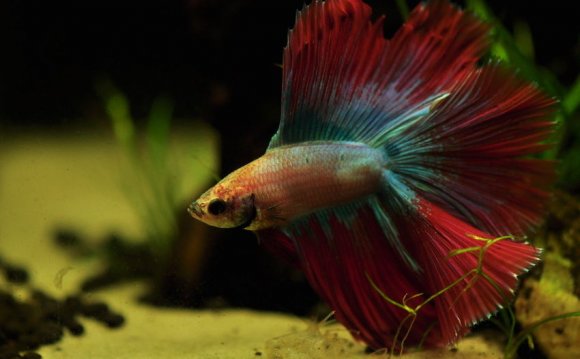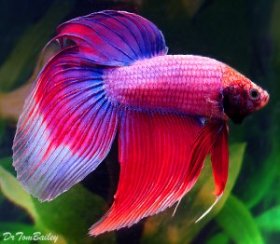

What does the bubble nest do?
Betta fish due to its natural habitat being shallow waters are surrounded with dirt, small rocks and puddle. The bubble nest provides a natural habitat for the eggs to grow healthily. It prevents any dirt or external object from interacting with the eggs. The bubbles make sure that the eggs are always surrounded with rich oxygen and are moist.
Even in the fish tanks without a female fish, the male Betta will make the bubble nest because of its instincts. There is no specific time frame for them or period of cycle to observe. It is just known that they do it from time to time with their instincts that the atmosphere is compatible for breeding process.
Betta Fish Breeding Process
If you want to increase the count of Betta in your tank, you can usually breed them. Breeding is a good thing for both the Betta and its owner as it happens only if the health and atmospheric conditions are perfect and vice versa.
But, the breeding process is a very complicated and time taking one. So, you will have to possess enough patience along with regularity in checking the conditions of the tank. The complete process of breeding is given below step by step:
The fish tank
- For any fish to breed, it needs to be healthy enough. So, setting up the fish tank and revising its condition before starting the breeding process is very crucial.
- After setting the conditions of the tank you need to bring a female Betta and prepare another similar tank for it. The female fish needs to be of the same size and similar age as the male fish.
Note: A young breeding pair of approximately 14 months of age is best for breeding as this age is perfect for the process and the results are most optimum.
- Do not place both the genders in the same tank. Betta fishes are territorial and will end up fighting to death for their territory. Even during the breeding time.
- Wait for 2-3 months for the fishes to settle in the environment and then go further on the breeding process. After they have settled increase the temperature of the tank to 80 degrees Fahrenheit as this is the preferred temperature for the breeding.
- Remove any gravel or similar substances and plastic plants from the tank as the eggs can get lost in them which will result in depressing the male fish and deteriorate the chances of healthy hatching of eggs.
- The water level must be maintained at six inches from the lower surface of the tank. Try using an adjustable filter and heater to change the environment as required.
The Breeding Season
- As the breeding period approaches start feeding the fishes live food and keep changing the water regularly to avoid any contamination. The two tanks need to be kept beside each other such that both the fishes could see each other.
- The female Betta will show signs that it is ready to spawn. The belly will look swollen vertical stripes appear on the body of the female fish when it is ready to spawn.
- Place the female in the tank of the male fish and observe the behavior of both. If there is any aggression in their behavior, remove the female fish and try again after a few days.
- The signs that they are getting ready to spawn is that the male fish will spread its fins and flaunt its colors showing off its masculinity to attract the female.
Note: There may be slight bullying by the male fish as it snaps at the fins of the female Betta. As long as it appears to be harmless, do not try to interfere. This behavior may last for several hours or even days.
- Then the male Betta will start building a bubble nest to attract the female to copulate. The female will then release the eggs and then try to stay away from the male.
Necessary point: The female will look paralysed while releasing the eggs. It is perfectly normal. Immediately remove the female after it starts moving again or it may try to eat the eggs itself.
Taking care of the eggs
- As soon as the female releases the eggs, the male fish will catch them with its mouth and place them in the bubble nest to grow.
- Both the fishes need utter care during the courtship period as they are susceptible to infections. Treating the tanks with MarOxy or any other similar medication is good to avoid any fungal attack on the eggs.
- Before the eggs hatch, keep a stock of live small insects to feed the new born. The new born are called fry. They will usually swim at the surface looking for the insects and live food.
- Cover the tank with a plastic sheet to avoid cold wind from getting in as the fries may develop pneumonia when they swim around the surface and catch the cold wind.
Betta Fish food and Diet Procedures
Betta fish is carnivorous and requires a high protein diet to thrive. In their natural habitat, they usually feed on live insects, blood worms, mosquitoes. Feeding your Betta with commercial carnivorous pellets is enough for a good diet.
Betta fish do like snack from time to time. The best snacks for them are frozen worms, freeze dried fish and blood worms. Though a Betta fish can eat anything it should and even if it should not, they do not. They are very choosy in the food they eat. Here is a list of their favourite and most nutritious foods:
- Fish Pellets – Betta pellets are the best source of nutrition for the Betta fish on a daily basis. Feed your fish around 2-3 pellets twice a day and it will get enough protein to stay healthy.
- Live Food – Live food for Betta includes insect larvae, mosquito larva, daphnia, brine shrimp and bloodworms. Live food is preferably fed to these fishes when they are in the healing process. When feeding live food, the tank needs to cleaned from the leftovers as they are likely to catch infection quickly.
- Frozen Food – Frozen food is more expensive than other options but liked the most by the Betta. They are mostly fed as snacks once or twice a week. Frozen food is better as the freezing kills all the germs and makes it harmless. Unfreeze the amount you need to feed.
- Freeze Dried Fish – This one food when fed regularly will make the Betta ignore any other food for ever. They like this food so much that they get addicted to it. Freeze dried fish is best for medication and vitamin intake for your fish.
How Often to feed Betta Fish
- Overfeeding is one of the main reasons for the Betta to get sick. They do not have a proper control over their appetite and in good tank conditions will eat any amount of pellets you feed them.
- This leads to constipation in them which is a major killer. The best option to void overfeeding is to provide only the amounts your Betta takes 2 minutes to devour.
- An overfed Betta will look swollen if it gets constipated and the eyes seem to be popping out of the head too. So, try not to get into that or the treatment will cost more than feeding it because of a slight negligence.
How Long Can Betta Go Without Eating?
Betta fish have a lot of endurance to starvation. So, if you plan to go out of town for a few days do not worry about your Betta as it will survive without eating.
Though, there are auto food devices which can be set at a particular time to feed to fish. They drop pellets into the water at the set times of the day which can help you in extending the vacation period without worrying about the tank either.









